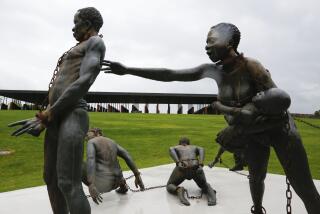The Emmett Till case is reopened nearly 63 years after the teen’s killing spotlighted racial violence
Reporting from ATLANTA — The investigation into the death of Emmett Till, one of the most notorious slayings of the Jim Crow-era Deep South, has been reopened more than 60 years after the 14-year-old African American boy’s mutilated body was pulled out of Mississippi’s Tallahatchie River.
Two white men, Roy Bryant and J.W. Milam, were prosecuted by state authorities in 1955 for the killing — only to be acquitted by an all-white jury after just an hour of deliberation. The case galvanized the civil rights movement, and even today, Till’s death has been invoked by protesters decrying brutality against African Americans.
In a report submitted to Congress in March, the Department of Justice said it had reopened its inquiry “based upon the discovery of new information.” The department did not elaborate, citing the ongoing nature of the investigation.
Long an enduring icon of the civil rights movement — inspiring poems, plays and songs from artists such as Langston Hughes, James Baldwin and Bob Dylan — Till has surged to modern-day consciousness as the nation has grappled with rising tension in recent years over a wave of violence and fatal police shootings of African Americans.
His casket has been positioned in the Smithsonian’s new National Museum of African American History and Culture in Washington, D.C. Historic preservationists have called for his modest red brick childhood Chicago home to receive official landmark status. His story has also sparked interest from Hollywood, with Jay-Z, Will Smith and Casey Affleck teaming up to produce an HBO mini-series about Till’s life, and Whoopi Goldberg and documentary filmmaker Keith Beachamp fundraising for a feature film titled “Till.”
Till’s slaying has also provoked 21st century cultural skirmishes. Last year, there were protests at the Whitney Biennial in New York City over “Open Casket,” a painting by artist Dana Schutz, who is white, that depicts Till’s open-casket funeral based on historical photographs. “It is not acceptable for a white person to transmute Black suffering into profit and fun,” a critic of the painting wrote, urging curators to destroy it.
Every time an unarmed black man is killed, for whatever reason, Emmett Till’s name comes up and we remember that past.
— Devery Anderson, author of a book about Till’s killing
“It amazes me just how this case continues to pop up,” said Devery Anderson, author of “Emmett Till: The Murder that Shocked the World and Propelled the Civil Rights Movement.” “Emmett Till is just the boy who never died, because with no justice served in this case, it kind of keeps the worst aspects of his case alive. ...The consolation is we’re continuously reminded of Till and how tragic it was and what things are like today.”
“Every time an unarmed black man is killed, for whatever reason, Emmett Till’s name comes up and we remember that past,” Anderson said in an interview on Thursday. “It’s the same story, really. ... It seems like the kind of thing we always have to work out later, go back and see the kind of impact it had and what it really meant.”
The boy from Chicago was visiting relatives in Money, Miss., in August 1955 when he walked into a white-owned grocery store. After one of the store owners, a 21-year-old white woman, Carolyn Bryant, said he had grabbed her and made crude sexual advances, white men later snatched him from his bed in the middle of the night.
Three days later, his body was found in the Tallahatchie River, along with a 75-pound cotton-gin fan tied to his neck with barbed wire. He had been beaten, tortured and shot in the head.
Till’s mother, Mamie Till Mobley, requested an open-casket funeral so that people around the world could witness her son’s disfigured, swollen body.
“Nobody would know Till’s name if it wasn’t for her,” said Patrick Weems, the director of the Emmett Till Interpretive Center, a museum set in the historic courthouse in Sumner, Miss., where the 1955 trial took place.
“It was really the first Black Lives Matter moment, because she made the world confront that and they didn’t want to,” Anderson said in an interview, noting that Till’s mother was criticized at the time for displaying her son. “Then, as now, we kind of use every trick in the book to not have to confront it, to not have to deal with it.”
The slaying — which took place a year after the Brown vs. Board of Education ruling desegregating schools and three months before Rosa Parks was jailed in Alabama for refusing to give up her bus seat — provoked national and international outrage about segregation and the brutal subjugation of blacks in the Deep South.
The men acquitted of the killing, Bryant and Milam, subsequently confessed to the crime in an interview with Look magazine. They are now dead.
However, the woman who made the allegations against Till, now known as Carolyn Bryant Donham, remains alive — and last year, a historian revealed that in an interview, she recanted some of her claims.
In a book published last year, “The Blood of Emmett Till,” Duke University professor Timothy B. Tyson wrote that Donham said of her allegations that Emmett grabbed her and was sexually crude toward her: “That part is not true.”
Till’s relatives and civil rights activists have long urged the Justice Department to prosecute any potential survivors involved in Till’s death. In 2004, the Justice Department reopened an investigation into the case, after a documentary filmmaker claimed as many as 14 individuals were involved. But the department decided not to bring charges, arguing that the five-year statute of limitation on federal civil rights violations had expired.
In 2007, the department referred the case to Mississippi prosecutors. However, a grand jury declined to bring a manslaughter indictment against Donham.
“The Emmett Till case started with one person, and that person is still alive,” Simeon Wright, Till’s cousin, told the Los Angeles Times in 2007 after the grand jury declined to indict Donham. “She played a role in identifying Emmett, she participated in his kidnapping and now she is getting away with murder.”
Wright, who witnessed Till’s abduction, died last September.
Other family members have continued to urge state and federal officials to reopen the case. Last week, Deborah Watts, one of Till’s cousins and a co-founder of the Emmett Till Legacy Foundation, wrote a piece for USA Today calling for the reopening of the investigation after reports that Donham had recanted part of her story.
“Our patience has worn thin,” she wrote. “Time is up!
“Is Donham above the law?” she added. “Does she never have to answer for being an accomplice in Emmett’s kidnapping and murder?”
Jarvie is a special correspondent.
Jarvie is a special correspondent.
UPDATES:
1:40 p.m.: This article was updated with comments from Devery Anderson and Patrick Weems.
12:25 p.m.: This article was updated with information about the depiction of Emmett Till’s death in popular culture.
11 a.m.: This article was updated throughout with Times reporting.
This article was originally published at 8:20 a.m.
More to Read
Sign up for Essential California
The most important California stories and recommendations in your inbox every morning.
You may occasionally receive promotional content from the Los Angeles Times.










